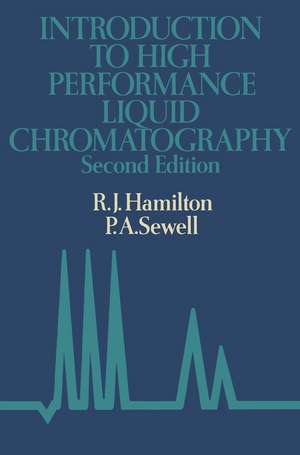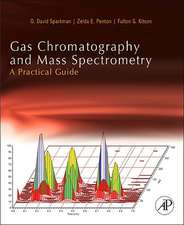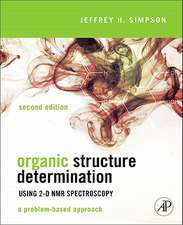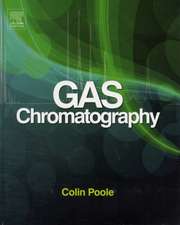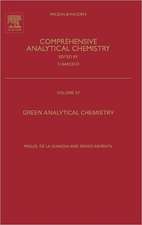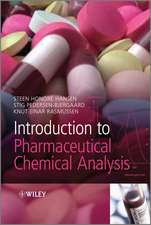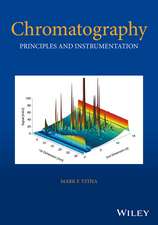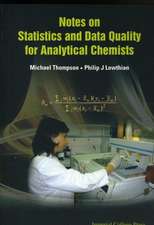Introduction to high performance liquid chromatography
Autor R. Hamiltonen Limba Engleză Paperback – 17 oct 2011
Preț: 386.00 lei
Nou
Puncte Express: 579
Preț estimativ în valută:
73.87€ • 76.68$ • 61.60£
73.87€ • 76.68$ • 61.60£
Carte tipărită la comandă
Livrare economică 22 martie-05 aprilie
Preluare comenzi: 021 569.72.76
Specificații
ISBN-13: 9789400959408
ISBN-10: 9400959400
Pagini: 260
Ilustrații: VIII, 248 p.
Dimensiuni: 155 x 235 x 14 mm
Greutate: 0.37 kg
Ediția:Softcover reprint of the original 1st ed. 1982
Editura: SPRINGER NETHERLANDS
Colecția Springer
Locul publicării:Dordrecht, Netherlands
ISBN-10: 9400959400
Pagini: 260
Ilustrații: VIII, 248 p.
Dimensiuni: 155 x 235 x 14 mm
Greutate: 0.37 kg
Ediția:Softcover reprint of the original 1st ed. 1982
Editura: SPRINGER NETHERLANDS
Colecția Springer
Locul publicării:Dordrecht, Netherlands
Public țintă
ResearchCuprins
1 Introduction to high performance liquid chromatography.- 1.1 Introduction.- 1.2 Nomenclature.- 1.3 Liquid Chromatography Modes.- 1.4 Scope of Techniques.- References.- 2 Chromatographic theory.- 2.1 The Process of Separation.- 2.2 Retention in Liquid Chromatography.- 2.3 Band Broadening-Origins.- 2.4 Band Broadening and the Plate Height Equation.- 2.5 Overall Plate Height Equation.- 2.6 Comparison with Gas Chromatography.- 2.7 Column Efficiency and Particle Diameter.- 2.8 Reduced Plate Height and Reduced Velocity.- 2.9 Extra-Column Band Broadening.- 2.10 Resolution.- 2.11 Resolution and Time for Analysis.- 2.12 Theory of Exclusion Chromatography.- References.- 3 Equipment.- 3.1 Introduction.- 3.2 Mobile Phase (Solvent) Reservoirs and Solvent Degassing.- 3.3 Pumping Systems.- 3.4 Flow Controllers.- 3.5 Solvent Flow Programming Equipment.- 3.6 Pulse Damping.- 3.7 Pressure Measurement.- 3.8 Filters.- 3.9 Sample Introduction Systems.- 3.10 Columns and Column Fittings.- 3.11 Column Thermostats.- 3.12 Liquid Chromatography Detectors.- 3.13 Flow rate Measurement.- 3.14 Fraction Collectors.- 3.15 Data Handling.- 3.16 Microprocessor Controlled HPLC.- References.- 4. Stationary phases in liquid chromatography.- 4.1 Introduction.- 4.2 Stationary Phase Types.- 4.3 Coltimn Packing Techniques.- 4.4 Liquid-Solid Chromatography.- 4.5 Liquid-Liquid Chromatography.- 4.6 Ion-Exchange Chromatography.- 4.7 Exclusion Chromatography.- 4.8 Care of Columns.- References.- 5. Mobile phases in liquid chromatography.- 5.1 Introduction.- 5.2 Solvent Qualities.- 5.3 liquid-Solid Chromatography.- 5.4 Liquid-Liquid Chromatography.- 5.5 Ion-Exchange Chromatography.- 5.6 Exclusion Chromatography.- 5.7 Gradient Elution.- References.- 6. Developing a chromatogram.- 6.1 Nature of the Problem.- 6.2 Choice of Chromatographic Mode.- 6.3 Selection of Stationary Phase and Mobile Phase.- 6.4 Choice of Detector.- 6.5 Chromatographic Separation.- 6.6 The General Elution Problem.- 6.7 Quantitative Analysis.- References.- 7. Preparative high performance liquid chromatography and trace analysis.- 7.1 Introduction.- 7.2 Stages in Preparative HPLC.- 7.3 Infinite Diameter Columns.- 7.4 Packing of a Preparative Column.- 7.5 Summary of Preparative HPLC.- 7.6 Trace Analysis.- References.- 8. Applications of high performance liquid chromatography.- 8.1 Pharmaceuticals.- 8.2 Biochemicals.- 8.3 Food Chemicals.- 8.4 Heavy Industrial Chemicals.- 8.5 Inorganic.- 8.6 Miscellaneous.- Compound Index.
